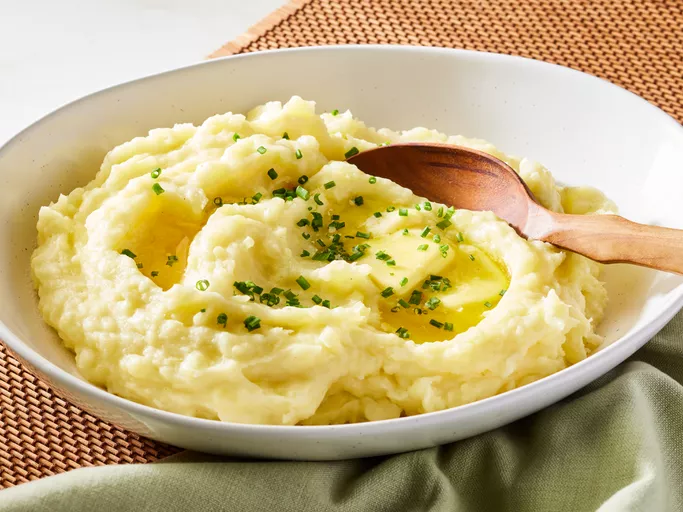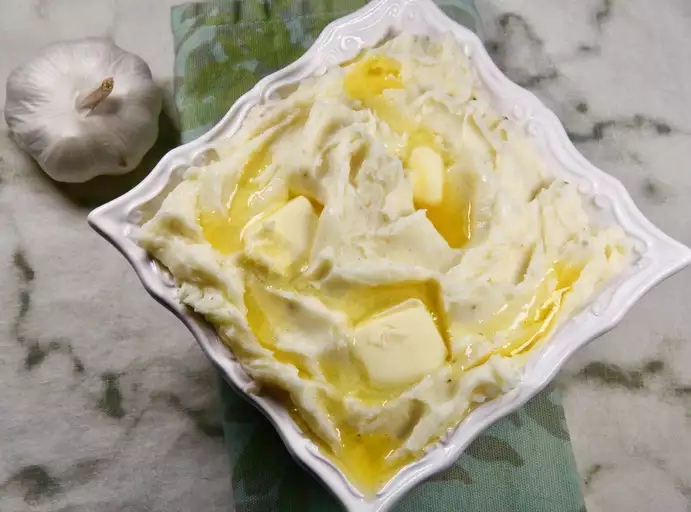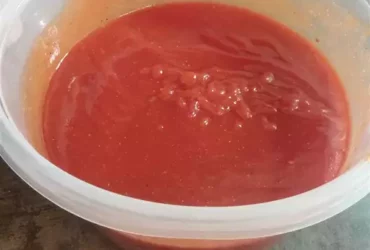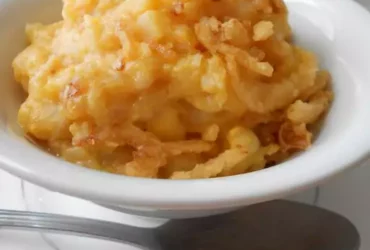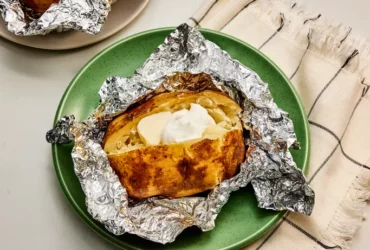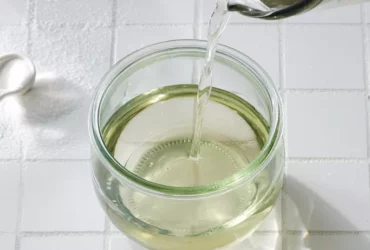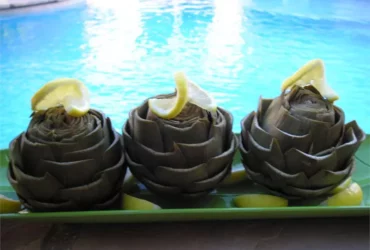Ingredients
Potatoes: Choose high-quality potatoes that are high in starch, such as Russet or Idaho.
When it comes to making garlic mashed potatoes, choosing the right type of potato is crucial. You want to select high-quality potatoes that are high in starch, as they will yield a lighter and fluffier texture when cooked.
The two most popular varieties of potatoes that fit this description are Russet and Idaho. These types of potatoes have a higher starch content than other varieties, which means they will hold their shape well when boiled and mashed.
Russet potatoes are known for their rough, brown skin and white flesh. They have a high starch content, making them ideal for mashing, baking, or frying. They also have a sweet, nutty flavor that pairs perfectly with the savory taste of garlic.
Idaho potatoes are another popular variety that is high in starch. They have a smooth, light brown skin and a white, fluffy interior. They have a mild, sweet flavor that will complement the garlic without overpowering it.
When selecting potatoes for your garlic mashed potatoes recipe, look for those that are firm and free of any bruises or blemishes. Avoid soft or sprouted potatoes, as they may be too old to use in cooking.
It’s also worth noting that you can mix and match different types of potatoes to achieve the desired texture and flavor. For example, combining Russet and Yukon Gold potatoes will give you a creamy, rich mash with a slightly sweet flavor.
In summary, choose high-quality potatoes like Russet or Idaho for your garlic mashed potatoes recipe. These varieties are high in starch, which will yield a light and fluffy texture when cooked, and have a mild, nutty flavor that pairs perfectly with the savory taste of garlic.
Garlic: Use 2-3 cloves of fresh garlic for every large potato.
Garlic is a fundamental ingredient in many cuisines around the world, and its inclusion in this recipe will undoubtedly elevate the flavor profile of the dish.
The key to incorporating garlic into your mashed potatoes lies in its proper ratio to other ingredients. Specifically, for every large potato you use, aim to incorporate 2-3 cloves of fresh garlic. This may seem like a generous amount, but trust that it will prove crucial in bringing out the rich, savory taste that defines this recipe.
When selecting your garlic, make sure to choose firm, plump bulbs with tight papery skins. These signs indicate freshness and will guarantee that your garlic has a potent, full-bodied flavor when cooked. Conversely, avoid soft or moldy bulbs as they may impart a bitter or unpleasant taste to your dish.
While the quantity of garlic is crucial in achieving the perfect balance, it’s equally important not to overpower other ingredients with its pungency. Therefore, be mindful of the overall flavor profile you’re aiming for and adjust the amount according to personal preference.
To further enhance the depth of your garlic mashed potatoes, consider roasting your cloves before incorporating them into the recipe. This simple step involves preheating your oven to 400°F (200°C), wrapping the bulbs in foil, and letting them roast for about 20-30 minutes or until their flesh is soft and easily mashed.
This approach will allow you to coax out even more of garlic’s hidden sugars and intensify its flavor. Once roasted, you can peel off the skin, mashing the cloves with your potatoes as instructed in this recipe. Be sure not to overdo it, though; too much garlic will quickly overpower any dish.
Instructions
Boil the Potatoes
To boil the potatoes for this garlic mashed potatoes recipe, start by peeling and washing four to six large potatoes, depending on their size. It’s essential to use high-quality potatoes that will yield a fluffy interior when cooked.
Cut the potatoes into large chunks or wedges, making sure they are all roughly the same size so they cook evenly. This is crucial for achieving perfectly cooked mashed potatoes with no raw or undercooked areas.
Place the potato chunks in a large pot and add enough cold water to cover them completely. The water level should be at least an inch above the top of the potatoes, as this will help prevent them from breaking apart during cooking.
Bring the water to a boil over high heat, then reduce the heat to medium-low and let it simmer for 15-20 minutes or until the potatoes are tender when pierced with a fork. You can test their doneness by inserting a fork into one of the potato chunks; if it slides in easily, the potatoes are ready.
While the potatoes are cooking, prepare the garlic butter by melting two tablespoons of unsalted butter and three cloves of minced garlic in a small saucepan over low heat. Stir occasionally to prevent the garlic from burning or becoming bitter.
Once the potatoes have cooked through, drain them thoroughly and return them to the pot. Add two tablespoons of milk or heavy cream, two tablespoons of grated cheddar cheese (optional), and one teaspoon of salt. Use an electric mixer or a potato masher to mash the potatoes until they’re smooth and creamy.
Add the garlic butter mixture to the mashed potatoes and stir until it’s fully incorporated. Taste and adjust the seasoning as needed, adding more salt, pepper, or milk if desired.
Place 2-3 large potatoes in a large pot and add enough cold water to cover them. Bring to a boil over high heat, then reduce the heat to medium-low and simmer for 15-20 minutes or until the potatoes are tender when pierced with a fork.
When it comes to instructions, clear and concise language is essential to ensure that tasks are executed correctly and efficiently. In this case, we have a simple yet effective example of an instruction set that guides us through the preparation of garlic mashed potatoes.
The first step in this recipe is to add large potatoes to a pot, which immediately sets the stage for what’s to come. The use of the word “large” gives the cook an idea of the quantity and quality of potatoes needed, while also establishing a clear expectation for the outcome.
The addition of cold water to cover the potatoes is another critical aspect of this instruction. It highlights the importance of proper measurement and attention to detail in achieving the desired result. By specifying “cold” water, the cook is also informed that room temperature or even refrigerator temperature water should be used to avoid overcooking the potatoes.
The transition from high heat to medium-low heat during the cooking process is another crucial aspect of this instruction set. The use of specific temperature ranges (high and medium-low) allows the cook to adjust the heat accordingly, ensuring that the potatoes are cooked evenly and thoroughly.
Finally, the addition of garlic to the mashed potatoes after they have been cooked is a great example of how a seemingly simple ingredient can elevate the dish to new heights. By specifying that the garlic should be “minced” or finely chopped, the cook is given clear instructions on how to prepare it for use.
Throughout this instruction set, attention has been paid to detail and clarity. The language used is concise and easy to understand, making it accessible to cooks of all skill levels. By breaking down the process into manageable steps, the cook is empowered to create a delicious and memorable dish that showcases the flavors and textures of garlic mashed potatoes.
Tips & Variations
Add Flavour
To take your garlic mashed potatoes to the next level, consider adding some extra flavor with different herbs and spices.
Firstly, you can try using roasted garlic instead of raw garlic for a deeper and nuttier flavor. Simply cut the top off of a whole head of garlic, drizzle with olive oil, and roast at 400°F (200°C) for about 30-40 minutes or until soft and caramelized.
Another option is to add some grated fresh ginger to your mashed potatoes for an Asian-inspired twist. This will not only add flavor but also a lovely aroma to your dish.
You can also try using different types of cheese, such as cheddar, parmesan, or feta, to give your mashed potatoes a unique flavor profile. Experiment with different combinations to find the perfect balance for your taste buds.
For an Italian-style garlic mashed potatoes, add some chopped fresh parsley and a sprinkle of dried oregano. This will give your dish a fresh and herbaceous flavor that pairs perfectly with grilled meats or seafood.
If you’re looking for a spicy kick, try adding some diced jalapeño peppers to your mashed potatoes. This will not only add heat but also a nice burst of freshness from the peppers’ bright green color.
Finally, don’t be afraid to get creative with your garlic mashed potatoes by using different types of potatoes. For example, use sweet potatoes for a sweet and nutty flavor or Yukon golds for a buttery and rich flavor.
These are just a few ideas to get you started, but feel free to experiment and come up with your own unique flavor combinations. The key is to taste as you go and adjust the seasoning to suit your taste buds.
After mashing the potatoes, stir in 1/4 cup of grated cheddar cheese, chopped fresh herbs like parsley or chives, or a pinch of paprika to give them an extra boost of flavour.
- The beauty of garlic mashed potatoes lies not only in their rich flavor but also in the versatility that allows you to customize them to suit your taste preferences.
- One of the easiest ways to elevate this classic recipe is by adding a sprinkle of grated cheddar cheese
- This will not only add an extra layer of creaminess to the dish but also introduce a subtle tanginess that complements the pungency of garlic.
- However, if you prefer a lighter option, you can opt for a lower-fat alternative such as reduced-fat cheddar or even feta cheese
- Another way to add an extra boost of flavor is by incorporating chopped fresh herbs, such as parsley or chives
- The bright, oniony flavor of these herbs pairs perfectly with the rich, creamy texture of the mashed potatoes.
- If you’re looking for a more subtle addition, a pinch of paprika can add a smoky depth to the dish without overpowering the other flavors
- You can also experiment with different types of cheese, such as goat cheese or feta, for a unique twist on this recipe
- The key is to find the perfect balance between flavors and textures that suits your taste buds.
- Best Datanyze Alternatives for 2025 - April 24, 2025
- Best Hunter.io Alternatives for 2025 - April 22, 2025
- Best Lead411 Alternatives for 2025 - April 22, 2025

